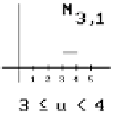Graphics Reference
In-Depth Information
uniform. “Nonperiodic” has been used to mean clamped nonuniform. The terms above
seem to make the most sense and are starting to be used. See [PieT95].
Two types of knot vectors are common enough to deserve a name.
Definition.
Let (u
0
,u
1
,...,u
n+k
) be the knot vector for a B-spline of order k. It will
be called the
standard uniform
knot vector if u
i
= i. It is called the
standard clamped
uniform
knot vector if
uu
===
...
,
u
=
0
0
1
k
-
1
u
=- +
i
k
1
for k
££
i
n
,
i
uu
=
=
...
u nk
=
-
+
2
.
(11.70)
n
+
1
n
+
2
n
+
k
To help the reader get a feel for the functions N
i,k
(u) we shall compute a few cases
using the standard clamped uniform knot vector. In this case we may assume that
0 £ u £ n - k + 2 because all the functions vanish outside that interval. Note that
to compute the N
i,k
(u) for a fixed k, we
must
use the
same
knot sequence for all
the N
i,j
(u), 1 £ j < k.
11.5.1.2
Example.
n = 3, k = 1:
Solution.
The knots u
i
in this case are
u
=
0
,
u
=
1
,
u
=
2
,
u
=
3
,
u
=
4
.
0
1
2
3
4
Figure 11.14 shows the graphs of N
i,1
(u).
11.5.1.3
Example.
n = 3, k = 2:
Solution.
This time the u
i
are
uu
==
0
,
u
=
1
,
u
=
2
,
uu
= =
3
.
0
1
2
3
4
5
Since the knot values have changed, we cannot use the N
i,1
(u) that were computed in
Example 11.5.1.2 and must recompute them. The new graphs are shown in Figure
11.15(a). The N
i,2
(u) reduce to the following:
Figure 11.14.
The functions N
i,1
(u) in Example 11.5.1.2.




